Best Humidity Level For Home (2024 Update)
Maintaining the ideal humidity level in your home is essential for your health, comfort, and even the integrity of the building itself. But with so many humidifiers and dehumidifiers on the market, how do you determine what’s best for your needs? As you evaluate options for regulating humidity in your indoor living spaces, here are some key factors to consider.
First, examine the size of the room or area you want to control moisture in. Measure square footage and ceiling height to help you select a system with adequate capacity. Consider getting multiple units for very large or open floorplans. Look at product specifications to match the coverage area to your spaces.
You’ll also want to determine your target humidity range. Most experts recommend keeping indoor relative humidity between 30-50% for optimal comfort and health. Levels below 30% tend to worsen respiratory ailments and dry out skin and sinuses. Above 50%, mold, bacteria, and pests thrive. Know your ideal zone before shopping.
How easy is the system to use and maintain? Humidistats, refillable tanks, filters, and alerts make monitoring and upkeep more convenient. And will the unit work with your existing HVAC equipment? Choosing one that seamlessly integrates will provide better whole-home humidity control.
Do you want smart features? Many models now connect to Wi-Fi and apps for remote access and voice controls. This allows you to regulate humidity from anywhere and receive notifications if levels go out of whack.
Take these factors into account while searching for the best humidity management system for your household. Protecting your indoor air quality helps safeguard your family’s health and your home’s integrity. Careful evaluation of your needs will help you find the right solution.
10 Best Humidity Level For Home
| # | Product Image | Product Name | Product Notes | Check Price |
|---|---|---|---|---|
|
1
|
Ideal for monitoring indoor humidity levels and room temperature.
|
|
||
|
2
|
Ideal for monitoring indoor temperature and humidity levels with a large touchscreen display and backlight.
|
|
||
|
3
|
Ideal for monitoring indoor temperature and humidity levels for increased comfort and health.
|
|
||
|
4
|
Ideal for monitoring indoor temperature and humidity levels in various settings like homes, greenhouses, incubators, humidor, and nursery rooms.
|
|
||
|
5
|
The product is ideal for measuring temperature accurately and quickly in various settings, both indoors and outdoors.
|
|
||
|
6
|
The product is ideal for monitoring indoor temperature and humidity levels in greenhouses, wine cellars, or other similar settings.
|
|
||
|
7
|
This product is ideal for measuring indoor humidity and temperature levels accurately and easily.
|
|
||
|
8
|
This product is ideal for monitoring temperature and humidity levels in indoor spaces for optimal comfort and health.
|
|
||
|
9
|
The product is ideal for monitoring indoor air quality, temperature, humidity, and dew point.
|
|
||
|
10
|
The product is ideal for measuring temperature and humidity levels in indoor environments.
|
|
1. Thermopro Humidity Monitor: Accurate & Efficient.
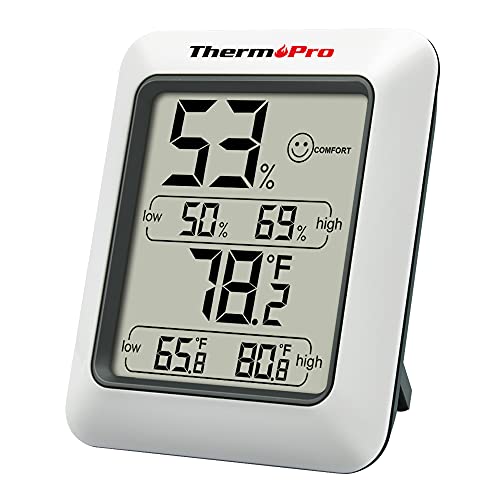
Introducing the humidity meter with an air comfort indicator – a reliable and efficient tool for monitoring your indoor environment. With just a quick glance at the humidity level icon, this meter indicates air conditions as DRY/COMFORT/WET – ensuring you're always aware of changes to your home/household.
Featuring a high accuracy of ±2-3%RH and ±1°F, this inside thermometer is ideal for measuring fluctuating readings like those found in a greenhouse. Data measurements are updated every 10 seconds to give you the latest updates on your environment, making it a quick and reliable tool for any situation.
In addition, this hygrometer digital thermometer displays high/low temperature and humidity levels, making it easy to compare data and make proper adjustments. Achieving proper indoor humidity levels is important for skin and allergies, making this thermometer hygrometer an essential tool for maintaining a healthier home and environment.
Not just limited to indoor use, this thermometer hygrometer with temperature and humidity monitor can also serve as a refrigerator thermometer, freezer thermometer, reptile thermometer, soil thermometer, humidor hygrometer, cigar hygrometer, and more.
Designed with practicality in mind, this indoor room thermometer comes with a tabletop stand and a magnetic back, allowing you to place the temperature monitor on your counter or fridge. The °F/°C selector is a convenient feature for easy temperature conversion. Powered by an AAA battery (included), this thermometer hygrometer is ready to use right out of the box.
2. Touchscreen Indoor Hygrometer And Thermometer
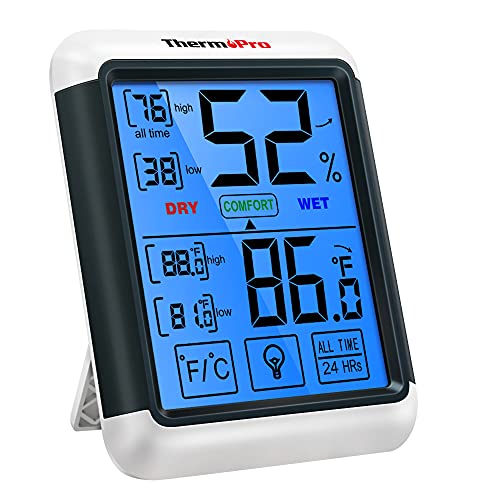
The humidity meter is an ideal tool for those looking for an accurate and responsive indoor temperature and humidity reader. With a large, 4-inch-LCD display that features a backlight and touchscreen, this device is easy to read in dimly lit environments and simple to operate.
This indoor thermometer boasts a high accuracy level, with readings that are within ±1°F/°C and ±2%–3% relative humidity (RH). This makes it perfect for use in a variety of rooms such as the living room, baby room, kitchen, greenhouse, guitar room, office, and cellar.
The humidity reader is designed to provide responsive and accurate readings of the current air conditions. This helps you to implement proper humidity control, which can benefit your skin and alleviate allergies and other health problems.
The digital thermometer also displays MAX & MIN humidity and temperature records and trends every 10 seconds, allowing you to adjust your thermostat or humidifier accordingly. This feature makes it easy to maintain an optimal level of humidity in your home.
For your convenience, this wall thermometer indoor comes with multiple placement options. It features a tabletop stand, wall mount, and built-in magnet that allows it to be used in any type of room. Additionally, it is selectable between °F/°C. The device is powered by 2 AAA batteries, which are included.
3. Black Slim Comfort Meter: Acurite Hygrometer & Thermometer
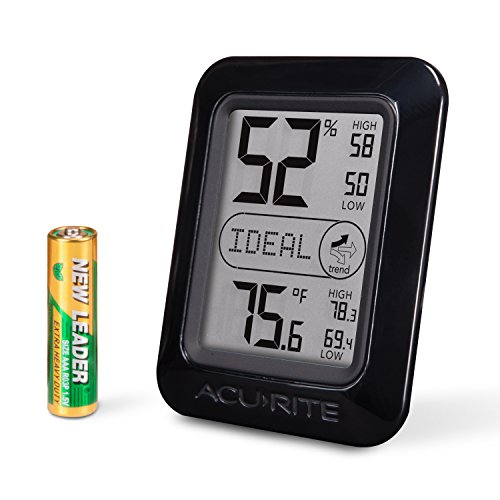
This temperature and humidity monitor boasts high-accuracy readings, making it an ideal choice for monitoring humidity levels in a variety of settings, from greenhouses to basements, and any place in between. Its compact display and easy-to-read digits allow users to stay informed of changes at a glance.
The monitor's display not only shows current humidity conditions, but also indicates trends, alerting users to humid, ideal, or dry air conditions and prompting adjustments to humidifiers or dehumidifiers to ensure optimal comfort. Its digital reading refreshes every 15 seconds, providing quick updates and keeping users informed of the latest trends.
Designed with versatility in mind, the monitor offers multiple placement options, including a foldout kickstand and magnetic back for placement on tables or metal surfaces, such as refrigerators or freezers.
The product also comes with US-based customer support, providing peace of mind for those seeking assistance with the product. The company itself is based in Lake Geneva, Wisconsin, USA, and has been in operation since 1943.
4. Govee Bluetooth Thermometer: Accurate Indoor Monitoring.
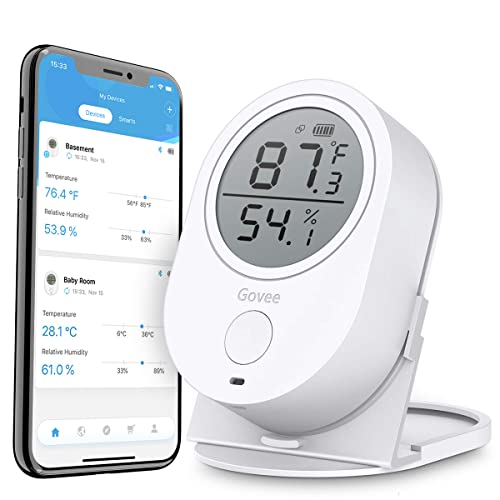
The Govee Bluetooth Thermometer Hygrometer is a convenient and efficient tool that helps monitor the temperature and humidity levels in your space. With a transmission range of up to 196 feet without obstructions, this device allows you to track temperature and humidity data remotely via Bluetooth on the Govee Home App, providing you with real-time data and updates.
One of the key features of this thermometer is its Smart App Alerts. You can set a preset temperature and humidity alert range via the Govee Home App, and if the current readings fall out of that range, you'll receive a notification instantly. This is particularly useful for monitoring your nursery room, cellar, basement, or terrarium, as it allows you to respond quickly to changes in the environment.
The Govee Bluetooth Thermometer Hygrometer boasts an accuracy level of ±0.54°F/℃ and ±3%RH, thanks to its built-in Swiss-made sensor. The device provides instant readings, with precise data refreshing every two seconds within the Govee digital temperature and humidity monitor. This ensures that you always have accurate and up-to-date information about the temperature and humidity levels in your space.
Another great feature of the Govee Bluetooth Thermometer Hygrometer is its 2-year data record and export capability. The device can record both temperature and humidity data for up to 2 years, and automatically synchronize the data to your phone via Bluetooth. You can export the data to CSV format at any time, providing you with a comprehensive record of your space's temperature and humidity levels.
Finally, the Govee Bluetooth Thermometer Hygrometer comes with two mounting options for added convenience and ease of use. It is designed with a mini round LCD screen and a unique base, allowing you to put it on a table or mount it onto the wall. The device also comes with a desk stand and wall mount bracket included, making it simple to decorate your room in a simple, stylish manner.
5. Extech Digit Thermometer
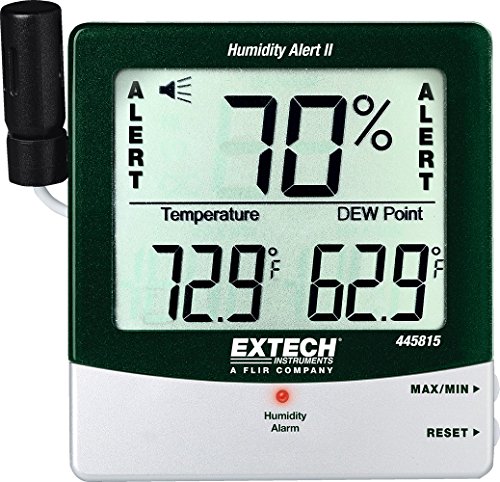
This advanced triple display device offers a comprehensive solution for monitoring and regulating humidity levels in your surroundings. With a large and easy-to-read display, it provides real-time readings of relative humidity, temperature, and dew point, enabling you to keep track of the conditions in your environment.
One of the standout features of this device is the alarm with a programmable set point. It gives a clear visual and audible warning when the humidity level exceeds the high or low limit that you have set. This feature is particularly useful in areas where humidity regulation is critical, such as factories, laboratories, and storage facilities, among others.
This device comes with a built-in stand, which makes it easy to place on a desk or table. Additionally, it comes with a bracket that enables you to mount it on a wall, providing added convenience. The ability to recall minimum and maximum readings is another feature that makes this device stand out. It allows you to keep track of the changes in humidity levels over time, which can be useful for identifying trends in your environment.
This device is an ideal monitoring solution in humid areas where mold can be a problem. By keeping a close eye on the relative humidity levels, you can take the necessary steps to prevent mold growth. Furthermore, it can be used in a variety of settings, including homes, offices, museums, and even greenhouses.
6. Govee Smart Hygrometer: Indoor Climate Control Made Easy
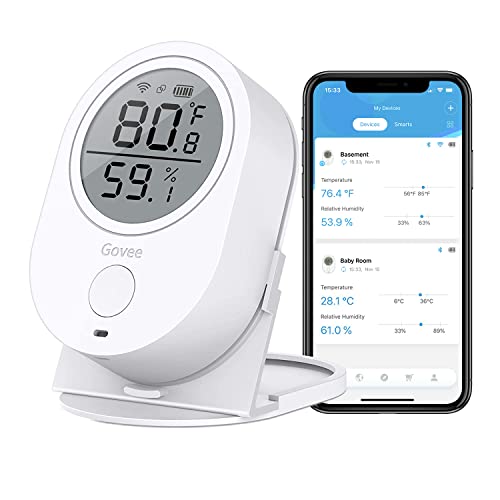
The WiFi Thermometer Hygrometer offered by Govee is a smart device that can remotely monitor humidity and temperature with ease. It can connect with a 2.4GHz WiFi network or Bluetooth, and it is designed to provide alerts to the user's phone when the readings exceed a preset value. This functionality makes it a perfect tool to monitor the house while the user is away from home.
The Govee Smart hygrometer thermometer is designed for accuracy, thanks to its Swiss-made sensor, which accesses temperature with an accuracy of ±0.54℉/±0.3℃, and humidity with an accuracy of ±3%. Dual display methods are available, allowing the user to choose between the clear LCD screen or the Govee Home app to check current temperature and humidity readings.
The thermometer is easy to install, thanks to the included back adhesive tape or tabletop stand. Additionally, the Govee WiFi thermometer hygrometer is designed to record data over two years and upload it to the phone via WiFi. The user can select different intervals of data as per their needs and export the last two years of data in CSV format.
The Govee Home app is a functional tool that comes with numerous features like a low battery alarm, easy setting, and data sharing. Users can log in with the same account to access these features. Additionally, users can switch the temperature unit between °F/°C, calibrate, and preset the alarm value using their fingers on the app. Double-tapping the button on the front face of the device allows the user to switch between °F/°C.
7. Acurite Digital Hygrometer: Accurate And Compact.
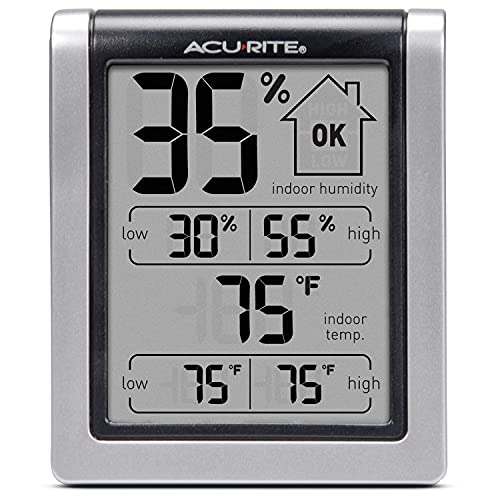
Maintain optimal indoor temperature and humidity levels effortlessly with this wireless indoor thermometer and hygrometer combination. Designed to work seamlessly with humidifiers or dehumidifiers, this home instrument provides a simple and easy-to-read display monitor that lets you view current temperature and humidity at a glance.
The indoor thermometer gauge and humidity sensor also allows you to track daily high and low indoor temperature and humidity levels, helping you better understand the range of conditions in any room. With the ability to switch temperature readings between Fahrenheit or Celsius, this wireless home instrument measures indoor temperatures from 32 °F to 122 °F (0 °C to 50 °C).
This sleek and versatile design offers multiple placement options to suit your needs. Use the integrated keyhole for wall mounting, the magnet for placement on a metal surface such as a refrigerator or freezer, or the fold-out kickstand for use on any flat surface. It's perfect as a desk thermometer too!
Measuring at 3" H x 2.5" W x 1.3" D, this indoor thermometer/hygrometer combination is compact and portable, making it easy to move around the house as needed. The company behind this product is based in Lake Geneva, WI, USA, and has been producing quality instruments since 1943.
8. Hygrotemp 2-Pack: Indoor Comfort At Home
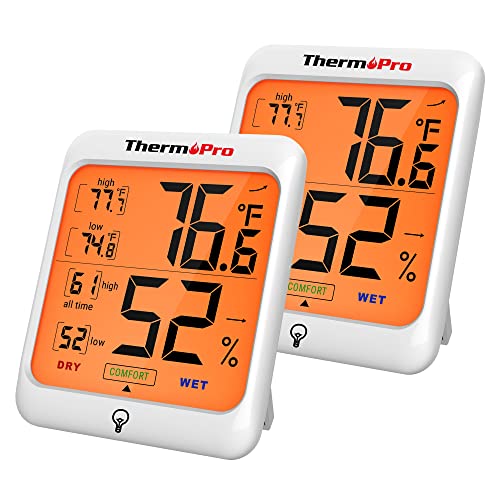
This temperature gauge is a highly informative and accurate tool that provides users with a wealth of data to help them regulate their home's temperature and humidity levels. Equipped with a humidity monitor that displays and stores all-time and 24-hour maximum and minimum records, this gauge also features an air comfort indicator that allows users to quickly assess the comfort level of their home.
One of the standout features of this gauge is its high accuracy and fast refresh rate. With an advanced temperature sensor, it provides accurate readings to within ±2.0°F(±1.1°C) and ±2-3%RH, and refreshes every 10 seconds to ensure that users are promptly informed of any changes to their home's temperature or humidity levels.
For added convenience, this gauge also includes a touch-sensitive backlight button on the sleek, narrow bezel below the display. This allows users to easily turn on the backlight in dark conditions, making it easy to read and interpret the data displayed on the screen.
Another great feature of this temperature gauge is its multiple placement options. With a tabletop stand, hanging mount, and strong-magnetic back, users can attach or place the digital humidity gauge wherever they desire, making it a versatile tool that can be used in a variety of settings.
This temperature gauge is perfect for ensuring proper temperature and humidity control, which can be beneficial for both skin and overall health. It can be used in a variety of settings, such as the baby room, nursery, cellar, basement, warehouse, greenhouse, and more.
9. Supco Indoor Air Quality Monitor & Dewpoint Sensor
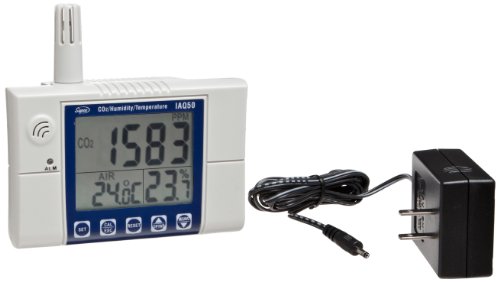
The Indoor Air Quality (IAQ) Meter is an essential tool for measuring the air quality of indoor environments. This meter is equipped with a CO2 sensor, which measures Carbon Dioxide levels, as well as temperature and humidity, with Dew Point and Wet Bulb. It is designed for use in residential and professional settings such as warehouses, restaurants, garages, and greenhouses, providing continuous monitoring of air quality.
To ensure maximum safety, the CO2 meter comes with a programmable, visible audio alarm (80dB). This alarm will alert you to high levels of Carbon Dioxide in the air. The beep can be manually stopped, but will automatically stop when the CO2 reading falls below the lower limit.
The IAQ meter is super portable, allowing you to bring it all around your home or workspace to test the air quality. You can easily mount it on the wall or place it on a desktop for convenience. Furthermore, the CO2 detector takes 30 seconds to warm up and has a large, triple function LCD display, so you can clearly see exactly what is going on with the air around you.
One of the most popular forms of CO2 sensing technology available is the Non-Dispersive Infrared Sensor (NDIR), which is used by the Supco IAQ50 CO2 Meter. This sensor provides accurate and reliable readings of CO2 levels, making it a must-have tool for anyone concerned about the indoor air quality of their home or workplace.
10. Fluke 971 Temperature Humidity Meter
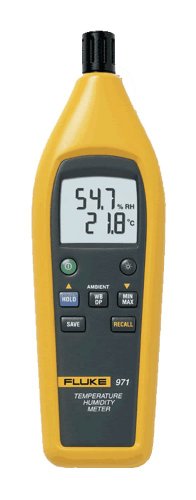
The humidity and temperature measuring device is a must-have for anyone who needs accurate readings. The device comes with a backlit dual display, which makes it easy to read in low light situations. The display shows both humidity and temperature readings.
In addition to measuring humidity and temperature, the device also measures dew point and wet bulb temperatures. This feature is particularly useful for those who work in the HVAC industry.
The device has a 99 record storage capacity, allowing the user to keep track of multiple readings over time. This feature is especially beneficial for those who need to keep records for compliance or quality control purposes.
The device has an ergonomic design, which includes a belt clip and protective holster. This design makes it easy to carry around and protects the device from damage.
The device has a quick response capacitance sensor, which ensures that accurate readings are obtained in a timely manner. This feature is particularly useful for those who need to take quick readings in fast-paced environments.
Best Humidity Level For Home FAQs
How can I find the best humidifier or dehumidifier for my home?
The best way to find the right humidifier or dehumidifier for your home is to first determine your needs. If you live in an area with high humidity levels, a dehumidifier might be the best option for you. On the other hand, if you live in a dry climate or have issues with dry skin or allergies, a humidifier might be the better choice.
Next, consider the size of the room or rooms you want to use the device in, as well as your budget. There are many different models and sizes available, so it's important to do your research and find one that fits your needs and budget.
It's also a good idea to read reviews from other customers who have purchased and used the product you are considering. This can give you valuable insight into the effectiveness and reliability of the device.
Finally, be sure to follow the manufacturer's instructions and recommendations for use and maintenance to ensure the longevity and effectiveness of your humidifier or dehumidifier.
How can I measure the humidity level in my home?
Measuring the humidity level in your home is important to ensure optimal comfort and prevent potential health issues. There are several ways to measure humidity at home. A hygrometer is a valuable tool that can measure both temperature and humidity levels in a room. You can purchase a digital hygrometer at most hardware or home improvement stores. Place the hygrometer in the room you want to measure and wait for the reading to stabilize. Another way to measure humidity is by using a psychrometer, which measures the difference between wet and dry bulb temperatures to determine the relative humidity. However, this method can be challenging for most homeowners. You can also estimate humidity levels by observing signs such as mold growth, condensation on windows, and musty odors. It is recommended to maintain indoor humidity levels between 30-50% to prevent the growth of mold and mildew and ensure optimal comfort.
How does humidity affect energy efficiency in a home?
Humidity can have a significant impact on the energy efficiency of a home. High humidity levels in a home can make it feel warmer, causing the HVAC system to work harder to maintain a comfortable temperature. This extra workload can lead to increased energy consumption and higher energy bills. Additionally, high humidity levels can cause moisture to build up on windows and walls, which can lead to mold growth and damage to the home's structure.
On the other hand, low humidity levels can also affect energy efficiency. When the air is too dry, it can cause static electricity, dry skin, and other health problems. To combat these issues, people often turn up the heat, which can lead to higher energy bills.
To maintain optimal energy efficiency, it's important to keep humidity levels in check. Ideally, the indoor humidity level should be between 30% and 50%. Homeowners can use dehumidifiers or humidifiers to regulate humidity levels and improve energy efficiency. Additionally, sealing air leaks and adding insulation can also help to reduce energy consumption and lower energy bills.
How does humidity affect indoor air quality?
Humidity plays a crucial role in indoor air quality. When the humidity levels in the air are too high, it can lead to the growth of mold, bacteria, and other harmful microorganisms. This can cause respiratory problems, allergies, and other health issues. On the other hand, if the humidity levels are too low, it can lead to dry skin, irritated eyes, and respiratory problems.
High humidity levels can also make the air feel heavy and uncomfortable, making it difficult to breathe. In addition, it can cause damage to furniture, flooring, and other materials in the home.
To maintain good indoor air quality, it is important to keep the humidity levels between 30-50%. This can be achieved by using a dehumidifier or air conditioner to remove excess moisture from the air. Regular cleaning and maintenance of HVAC systems can also help improve indoor air quality by reducing the presence of mold, dust, and other allergens.
What are some common signs of high or low humidity in a home?
Humidity refers to the amount of moisture or water vapor present in the air. Maintaining an optimal level of humidity in your home is important for your health and comfort. Here are some common signs of high or low humidity in a home:
High humidity:
– Mold or mildew growth in bathrooms, kitchens, or basements
– Musty or stale odors
– Condensation on windows and walls
– Damp or moist air
– Skin feels clammy or sticky
– Difficulty in breathing
– Increased allergy symptoms
Low humidity:
– Dry or itchy skin
– Static electricity
– Cracked or peeling paint or wallpaper
– Chapped lips or dry throat
– Increased susceptibility to colds, flu, and other respiratory infections
– Difficulty in sleeping
– Wooden furniture or floors cracking or warping
To maintain an optimal level of humidity, it is recommended to keep the humidity level between 30-50% in your home. Using a humidifier or dehumidifier can help regulate the humidity level in your home and prevent any potential health problems.
What are some common sources of humidity in a home?
Humidity is the amount of moisture present in the air. It is an essential factor that contributes to the comfort and health of individuals in a home. However, too much humidity can lead to problems like mold growth, musty odors, and respiratory issues. Some common sources of humidity in a home include cooking, showering or bathing, drying clothes indoors, using a humidifier, and even breathing. When you cook, the steam from boiling water or the moisture from cooking food can contribute to the humidity levels in your home. Similarly, showering or bathing can also create a significant amount of moisture in the air. Drying clothes indoors can also increase indoor humidity levels, especially if the clothes are hung to dry in a small room with poor ventilation. Using a humidifier to add moisture to the air can also contribute to high humidity levels. Finally, even the simple act of breathing can add moisture to the air, especially in a tightly sealed room. It is essential to monitor indoor humidity levels and take steps to reduce humidity if it becomes excessive.
What are some effective ways to regulate the humidity level in a home?
Maintaining an appropriate level of humidity in your home is vital for the overall comfort and health of your family. High humidity levels can lead to the growth of mold and mildew, whereas low humidity levels can cause dry skin, nosebleeds, and respiratory problems. Here are some effective ways to regulate the humidity level in your home:
1. Use a dehumidifier – A dehumidifier is a great tool for removing excess moisture from the air. It works by drawing in humid air and extracting the water vapor, leaving the air drier and more comfortable.
2. Ventilate – Proper ventilation is essential for maintaining healthy indoor air quality. Open windows and doors to improve air circulation, especially during humid days.
3. Use air conditioning – Air conditioning not only cools your home but also removes moisture from the air. Make sure your AC unit is properly sized for your home to ensure maximum efficiency.
4. Seal air leaks – Air leaks around doors and windows can allow humid outdoor air to enter your home. Seal these leaks to prevent excess moisture from entering your home.
5. Use houseplants – Certain houseplants can help regulate humidity levels by absorbing excess moisture from the air. However, be careful not to overwater them as this can lead to increased humidity levels.
By implementing these effective ways, you can regulate the humidity level in your home and ensure a comfortable and healthy living space.
What are the benefits of maintaining a consistent humidity level in a home?
Maintaining a consistent humidity level in a home can have several benefits. Firstly, it can improve indoor air quality by reducing the growth of mold, mildew, and dust mites, which thrive in humid environments. This can help to reduce the risk of respiratory problems such as allergies and asthma.
Secondly, a consistent humidity level can help to preserve your home's furnishings and belongings. High humidity levels can cause wood to warp, paint to peel, and fabrics to rot, while low humidity can cause wood to crack and furniture joints to loosen. A consistent humidity level can help to prevent these issues and extend the lifespan of your home's contents.
Thirdly, maintaining a consistent humidity level can lead to energy savings. High humidity levels can make a home feel warmer than it actually is, causing the air conditioning to work harder than necessary. Conversely, low humidity levels can make a home feel cooler, causing the heating system to work harder. By maintaining a consistent humidity level, you can increase comfort levels while reducing energy consumption and costs.
Overall, maintaining a consistent humidity level can lead to a healthier, more comfortable, and more cost-effective home.
What are the health risks associated with high or low humidity levels in the home?
Humidity levels in the home can have a significant impact on our health and well-being. High humidity levels can create an environment that is conducive to the growth of mold and mildew, which can lead to respiratory problems, allergies, and asthma. It can also make it harder for our bodies to cool down, leading to heat exhaustion or heat stroke.
On the other hand, low humidity levels can cause dry skin, dry eyes, and respiratory problems. It can also increase the risk of infections as viruses and bacteria thrive in dry environments. Low humidity levels can also exacerbate existing health conditions such as allergies, asthma, and eczema.
It is recommended to maintain a humidity level between 30-50% in the home to promote good health and prevent these health risks. Using a humidifier or dehumidifier can help regulate humidity levels and improve indoor air quality. It is also important to ensure proper ventilation and regular cleaning to prevent the growth of mold and mildew.
What is the ideal humidity level for a home?
The ideal humidity level for a home is typically between 30% to 50%. Humidity levels above 50% can create an environment that promotes the growth of mold, mildew, and other bacteria, which can lead to health issues for occupants and damage to the home. On the other hand, humidity levels that are too low can cause dry skin, respiratory problems, and damage to wood furniture and flooring.
Maintaining the ideal humidity level can be achieved through the use of humidifiers and dehumidifiers, depending on the climate and season. In warmer months, a dehumidifier can help reduce excess moisture in the air, while in colder months, a humidifier can add moisture to the dry air. It's also important to properly ventilate areas prone to moisture, such as bathrooms and kitchens, and to regularly check for leaks or water damage.
Overall, maintaining a healthy humidity level in the home can promote comfort, health, and protect the integrity of the home's structure and furnishings.







